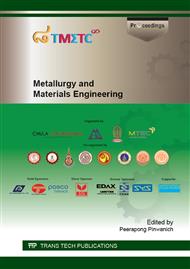p.59
p.64
p.69
p.76
p.81
p.86
p.91
p.96
p.101
Flow Curves Prediction of Heat Treated Boron Alloy Steels for Hot Stamping Process
Abstract:
Automotive parts made of ultra-high strength steels (UHSS) have been increasingly produced by hot stamping or press hardening of boron alloy steel. In case of novel hot formed components with tailored properties, different heating cycles needed to be applied for different zones, in which varying microstructure characteristics were generated. Mechanical properties of these parts were thus precisely controlled by the microstructure constituents. In this work, stress-strain behaviors of a boron alloy steel undergoing different heat treatment conditions with respect to that modified hot stamping procedure were predicted. Firstly, boron alloy steel sheet specimens were heated up to the austenitization temperature. Afterwards, they were abruptly cooled down to the bainitic temperature range, held for different holding times and finally cooled to room temperature. The microstructures obtained from each condition were characterized by optical microscope (OM) using color tint etching. The stress-strain responses of all generated microstructures were determined by tensile test. By the modeling, flow curves of the individual single phases were described taking into account a dislocation theory based model and their chemical composition. Subsequently, effective flow curves of the heat treated boron alloy steels were calculated by means of the isostrain and non-isostrain method and were finally compared with the experimentally determined curves.
Info:
Periodical:
Pages:
81-85
Citation:
Online since:
July 2015
Keywords:
Price:
Сopyright:
© 2015 Trans Tech Publications Ltd. All Rights Reserved
Share:
Citation:


